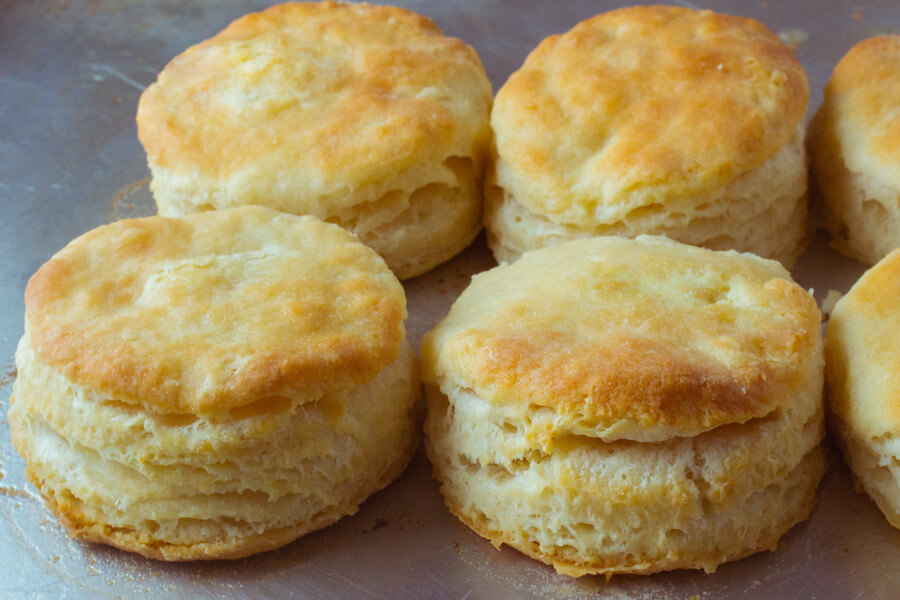If you have tried making biscuits at home, and ended up with flat biscuits instead of tall, fluffy buttery biscuits that your family loved then give this post read! I’ve got 10 reasons why your biscuits are not coming tall and fluffy like you want.
When it comes to baking homemade biscuits, they are quite easy technically. Biscuits are quick to make, and require just a few simple ingredients, but a lot can go wrong if you don’t know some biscuit baking basics.
I’ve been making homemade biscuits now for years and am hoping I can pass on to you some of my biscuit knowledge that I’ve picked up over my many baked batches. Because let’s face it, flat biscuits are biscuits that nobody wants to eat! We want golden brown, flaky, tender biscuits that rise nice and tall.
So today I’m sharing with you ten mistakes you might be making with your biscuit recipes that might explain why your biscuits spread out instead of rise up nice and tall.
After you give this article a read, I know your next batch of homemade biscuits are going to be your best biscuits ever. Then all you need to do is brush biscuits with some melted butter in the end, dig in and enjoy!
If the fat melts or softens before the biscuits bake, the biscuits will be hard and flat because there’s no place for the CO2 to go except out of the biscuits. Don’t work in a hot kitchen. If the dough seems to be getting too soft or warm, place it in the freezer for 10 to 15 minutes.

Mistake #4: Fat was too warm
Biscuits are made with some sort of type of fat, usually butter but they can also be made with another type of fat such as lard or vegetable shortening. Whichever fat you choose to use in your biscuits you need to make sure your fat is very cold as opposed to room temperature butter or melted butter.
The fat needs to stay cold so it stays solid in the biscuit dough, otherwise the fat melts becomes absorbed into the flour mixture resulting in biscuits that spread out.
When the cold butter finally melts in the oven, it will create steam and push apart the layers of flour creating tall biscuits instead of flat ones.
To keep the dough as cold as possible, I recommend using a pastry cutter to cut the cold butter into your dough instead of using your hands which can warm up the butter too much. Another method I know bakers love to add butter is using a box grater and grating frozen butter into the flour. Another great option!
You can also use a rolling pin to roll out the dough, although I don’t, but this could also help to keep the biscuit dough colder if you are worried about your hands warming up the dough too much.
Pro Tip: I always recommend after you cut out your biscuits, cover the baking sheet with plastic wrap and place it into the fridge for 20 minutes or freezer for 10 minute to firm up the butter or other fat again before baking.
Mistake #1: Baking powder and baking soda are OLD.
Baking powder and baking soda are what we call chemical leavening agents, meaning they make our baked goods rise. A chemical leavening agent will form carbon dioxide bubbles making your biscuits rise.
But your leavening agents can expire over time meaning they won’t react like they should in your recipe, so your biscuits won’t rise well. If you’re unsure how old that can of baking powder is in your cupboard you can always test it out before you start.
You can test your baking powder in a little hot water before you start. If the baking powder bubbles, then it’s still safe to use. If it doesn’t throw it out and get fresh.
Baking soda will react with the acidic ingredients, like the buttermilk in your biscuit recipe. You can test your it by mixing a little with some lemon juice or vinegar to see if it bubbles. If it doesn’t, then throw it out and get a fresh box.
It’s important to mention that baking powder and baking soda, are not the same thing and should not be used interchangeably in your biscuit recipe as well. So be sure to not mix them up and use as directed in the recipe so the homemade biscuits rise tall
Mistakes Everyone Makes When Baking Biscuits
FAQ
Why do buttermilk biscuits not rise?
Why aren t my biscuits light and fluffy?
How do you make my biscuits rise higher?
Why are my biscuits flat and dense?
